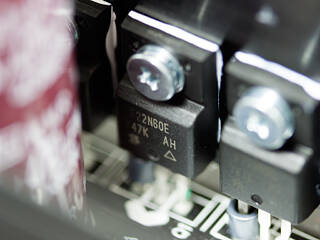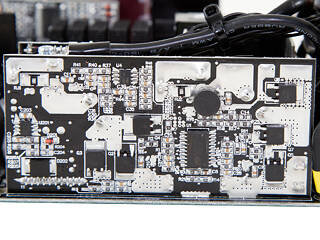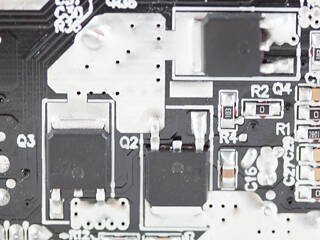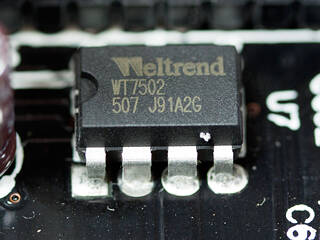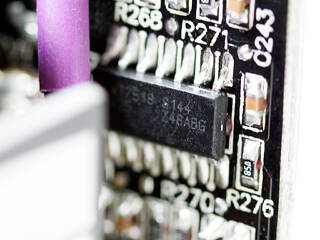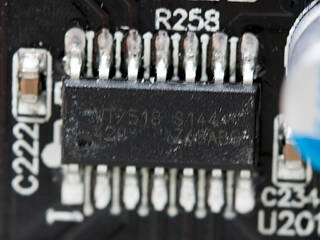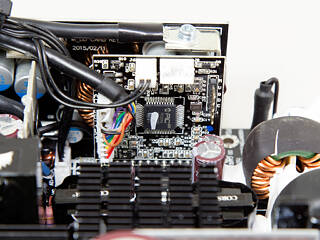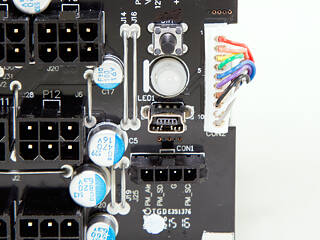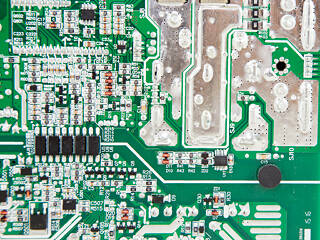 29
29
Corsair RMi Series 1000 W Review
Load Regulation, Hold-up Time & Inrush Current »A Look Inside & Component Analysis
Before reading this page, we strongly suggest a look at this article, which will help you understand the internal components of a PSU much better. Our main tool for the disassembly of the PSU is a Thermaltronics TMT-9000S soldering and rework station. It is of extreme quality and is equipped with a matching de-soldering gun. With such equipment in hand, breaking apart every PSU is like a walk in the park!| Corsair RM1000i Parts Description | |
|---|---|
| Primary Side | |
| Transient Filter | 6x Y caps, 2x X caps, 2x CM chokes, 1x MOV |
| Bridge Rectifier(s) | 2x GBJ25L06 (600V, 25A @ 100°C) |
| Inrush Current Protection | NTC Thermistor |
| APFC Mosfets | 3x Vishay Siliconix SIHF22N60E (650V, 13A @ 100°C, 0.18Ω @ 25°C) |
| APFC Boost Diode | 1x CREE C3D10060A (600V, 14A @ 135°C) |
| Hold-up Cap(s) | 2x Nippon Chemi-Con (400V, 680uF & 470uF or 1150uF combined, 105°C, KMR series, 2000h @ 105°C). |
| Main Switchers | 2x Vishay Siliconix SiHG30N60E (650V, 18A @ 100°C, 0.125Ω @ 25°C) |
| APFC Controller | Infineon ICE3PCS01G - CM03X |
| Switching Controller | Infineon ICE2HS01G |
| MCU | PIC32MX |
| Topology | Primary side: Half-Bridge & LLC Resonant Converter Secondary side: Synchronous Rectification & DC-DC converters |
| Secondary Side | |
| +12V | 8x Sinopower SM4021NAKP (40V, 100A @ 100°C, 2.7mΩ ) @ VGS=6V) |
| 5V & 3.3V | DC-DC Converters: 4x M3006D & 2x M3004D fets PWM Controllers: 1x APW7159 |
| Filtering Capacitors | Electrolytics: Chemi-Con (105°C, KZE series) Polymers: Chemi-Con |
| Supervisor IC | Weltrend WT7502 & 2x Weltrend WT7518 |
| Fan Model | NR135P (12 V, 0.22 A, fluid dynamic bearing) |
| 5VSB Circuit | |
| Rectifying Diode | PFR20V45CT (45V, 20A, VF: 0.42V max @ 125°C) |
| Standby PWM Controller | - |
This is actually a HX1000i with some component changes that lowered efficiency a tad while boosting performance everywhere else. The RM1000i, for example, not only uses exclusive Japanese capacitors and has much larger bulk capacitors (1150uF combined capacity vs 940uF of the HX1000i), which will significant increase hold-up time. We don't know the actual reasons behind these changes, but Corsair made a point of further improving the platform in some rather crucial areas, which is very strange considering the RMi line is situated below the HXi series.
This unit's heatsinks are very small and the secondary side doesn't even come with a proper heatsink. CWT's latest design approach, it seems to work well in even semi-passive PSUs, and Corsair is obviously very confident about the design's reliability or the unit wouldn't come with a seven year warranty.
The first part of the AC receptacle hosts two Y caps, and the main PCB holds another four Y caps, two X caps, and two CM chokes. There is also an MOV to protect the unit against spikes from the power grid.
The two GBJ25L06 bridge rectifiers are installed on a small dedicated heatsink.
The APFC converter utilizes three Vishay Siliconix SIHF22N60E fets and a CREE C3D10060A boost diodes. Both bulk caps are provided by Chemi-Con (400V, 680uF & 470uF or 1150uF combined, 105°C, KMR series, 2000h @ 105°C) and their combined capacity is very large for even a 1 kW PSU, which is good.
The main switchers are two Vishay Siliconix SiHG30N60E fets that are supported by an LLC resonant converter.
Here is the NTC thermistor that protects the unit against large inrush currents.
The APFC controller, an Infineon ICE3PCS01G, and a CM03X Green PFC controller are on a vertical daughter board that also hosts the resonant controller, an Infineon ICE2HS01G IC.
As has already been noted, there are no proper heatsinks in the secondary side. The mosfets that regulate the +12V rail, eight Sinopower SM4021NAKPs, installed on two vertical daughter-boards, are cooled by the bus-bars that transfer power to and from them. All electrolytic caps are also by Chemi-Con; these caps are rated at 105°C.
Both VRMs (Voltage Regulation Modules) are installed on this large vertical PCB. Their common PWM controller is an Anpec APW7159, and each VRM comes with two M3006Ds and one M3004D.
A Weltrend WT7502 supervisor IC is installed on the mainboard. There are also two WT7518 supervisor ICs on the modular PCB; these probably provide OCP for the +12V rail once you enable multi-rail mode through Corsair Link.
The SBR that regulates the 5VSB rail is a PFR20V45CT that can handle up to 20A of current.
This board hosts the MCU (PIC32MX) that allows the PSU to communicate with the Corsair Link software. This PSU's platform is controlled by analog components; however, it also features a digital interface to transmit data about its state. The digital interface even allows you to control the cooling fan. The Corsair Link software provides interesting options as it can be used to monitor and log fan speed and current or +3.3V, +5V, and +12V voltages. You can also monitor power-out, check power-in and efficiency or enable and disable OCP on the +12V rails.
The modular PCB's primary side is only covered in polymer filtering caps by Chemi-Con. The HX1000i uses Apaq and Enesol here, which might be good as well, but we strongly believe that these Chemi-Cons are even better. Several thick cables on the back of the modular board transfer power from the main PCB to the modular sockets.
Soldering quality is very good. We didn't spot any long component leads.
The RM1000i uses the same fan as the HX1000i. It is a very quiet fan at even higher speeds, and its model number is NR135P (12 V, 0.22 A). Under normal ambient temperatures, the fan speed won't exceed 1200 RPM even with a full load, and only a worst-case scenario (>48°C ambient and a full-load for a very long time) will have it operate at around 1550 RPM.
Apr 9th, 2025 01:19 EDT
change timezone
Latest GPU Drivers
New Forum Posts
- PSA: if your 5070 Ti freezes up (even the mouse cursor won't move) with Furmark. Try turning off Gsync to fix it! (0)
- issue with restart after changing throttlestop settings (5)
- ThrottleStop - 14900HX, 4090RTX MSI laptop (8)
- Stock PSU with Razer Core X with adapter to 12VHPWR (6)
- Cache Ratio stuck at 600hz lower than Turbo Cores with Ring Down Bin on (1)
- 2006 Macbook Pro Modern Sleeper Project (11)
- Comet Lake vs Rocket Lake Lga1200. (20)
- Post your cooling. (208)
- (Some of) What I'd like to See From a Final Fantasy IX Remake (2)
- Looking for 4060 MXM-A VBIOS (2)
Popular Reviews
- The Last Of Us Part 2 Performance Benchmark Review - 30 GPUs Compared
- MCHOSE L7 Pro Review
- UPERFECT UStation Delta Max Review - Two Screens In One
- PowerColor Radeon RX 9070 Hellhound Review
- Sapphire Radeon RX 9070 XT Pulse Review
- Upcoming Hardware Launches 2025 (Updated Apr 2025)
- Sapphire Radeon RX 9070 XT Nitro+ Review - Beating NVIDIA
- ASUS Prime X870-P Wi-Fi Review
- AMD Ryzen 7 9800X3D Review - The Best Gaming Processor
- DDR5 CUDIMM Explained & Benched - The New Memory Standard
Controversial News Posts
- NVIDIA GeForce RTX 5060 Ti 16 GB SKU Likely Launching at $499, According to Supply Chain Leak (164)
- MSI Doesn't Plan Radeon RX 9000 Series GPUs, Skips AMD RDNA 4 Generation Entirely (146)
- Microsoft Introduces Copilot for Gaming (124)
- AMD Radeon RX 9070 XT Reportedly Outperforms RTX 5080 Through Undervolting (119)
- NVIDIA Reportedly Prepares GeForce RTX 5060 and RTX 5060 Ti Unveil Tomorrow (115)
- Over 200,000 Sold Radeon RX 9070 and RX 9070 XT GPUs? AMD Says No Number was Given (100)
- Nintendo Switch 2 Launches June 5 at $449.99 with New Hardware and Games (97)
- NVIDIA GeForce RTX 5050, RTX 5060, and RTX 5060 Ti Specifications Leak (97)











